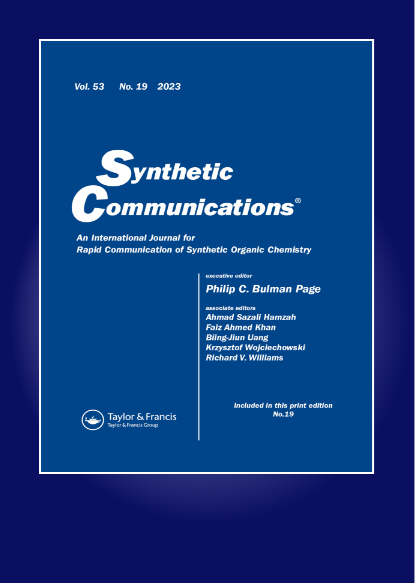A one-pot route to novel 3-{1-([5-amino-7-(arylamino)-6-cyano-7H-[1,4]oxaphosphinino[2,3-d]thiazol-2-yl]hydrazinyl)ethylidene}-2H-chromen-2-one: Synthesis, cytotoxic activities, apoptosis, and cell cycle studies
IF 1.8
3区 化学
Q3 CHEMISTRY, ORGANIC
引用次数: 0
Abstract
An innovative and efficient one-pot approach has been established for the synthesis of 3-{1-([5-amino-7-(arylamino)-6-cyano-7H-[1,4]oxaphosphinino[2,3-d]thiazol-2-yl]hydrazinyl)ethylidene}-2H-chromen-2-one (2a–h) using aromatic amine, phosphorus trichloride, malononitrile, and 3-{[1-(4-oxo-5H-thiazol-2-yl)hydrazinyl]ethylidene}-2H-chromen-2-one with triethylamine. This method is efficient and straightforward, offering high yields, easy product isolation, and minimal waste. The cytotoxic properties against PC3, LS174T, and HepG2 cancer cell lines revealed promising activity for compounds 2d and 2e (fluorine and chlorine substitutions), comparable to Tivozanib. Flow cytometry indicated that these bioactive compounds significantly increased late apoptosis and halted cell cycle progression at S and G2 phases, demonstrating their potential as anticancer agents. Both compounds 2d and 2e were then subjected to a molecular docking experiment to see how they bind with VEGFR-2 receptor.
新型3-{1-([5-氨基-7-(芳基氨基)-6-氰基- 7h -[1,4]草磷酰[2,3-d]噻唑-2-基]肼基)乙基}- 2h - chromen2 -one:合成、细胞毒性活性、细胞凋亡和细胞周期研究
建立了以芳香胺、三氯化磷、丙二腈和3-{1-(4-氧-5 -噻唑-2-基)肼基]乙基}- 2h - chromen2 -one为原料合成3-{1-(5-氨基-7-(芳基氨基)-6-氰基- 7h -[1,4]磷磷基[2,3-d]噻唑-2-基]肼基]乙基}- 2h - chromen2 -one (2a-h)的创新高效一锅法。这种方法是有效和直接的,提供高产量,易于产品分离,和最小的浪费。对PC3、LS174T和HepG2癌细胞系的细胞毒性显示,化合物2d和2e(氟和氯取代)的活性与Tivozanib相当。流式细胞术显示,这些生物活性化合物显著增加了晚期细胞凋亡,并在S和G2期停止了细胞周期进程,显示了它们作为抗癌药物的潜力。然后对化合物2d和2e进行分子对接实验,以观察它们如何与VEGFR-2受体结合。
本文章由计算机程序翻译,如有差异,请以英文原文为准。
求助全文
约1分钟内获得全文
求助全文
来源期刊

Synthetic Communications
化学-有机化学
CiteScore
4.40
自引率
4.80%
发文量
156
审稿时长
4.3 months
期刊介绍:
Synthetic Communications presents communications describing new methods, reagents, and other synthetic work pertaining to organic chemistry with sufficient experimental detail to permit reported reactions to be repeated by a chemist reasonably skilled in the art. In addition, the Journal features short, focused review articles discussing topics within its remit of synthetic organic chemistry.
 求助内容:
求助内容: 应助结果提醒方式:
应助结果提醒方式:


